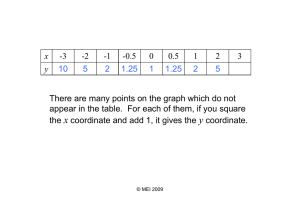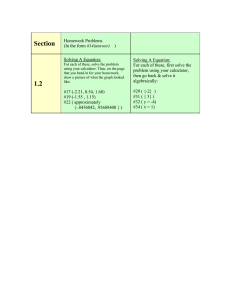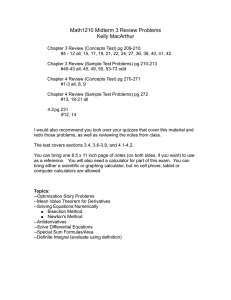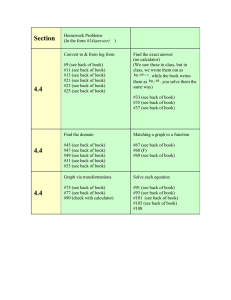Calculators in GCE Maths
advertisement
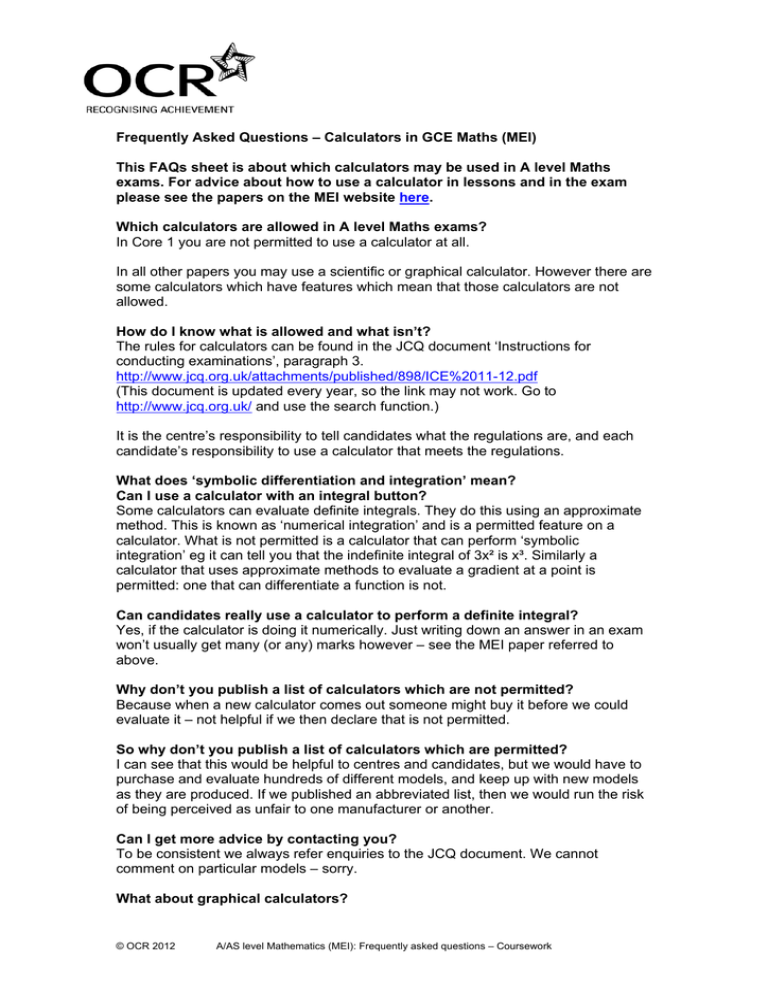
Frequently Asked Questions – Calculators in GCE Maths (MEI) This FAQs sheet is about which calculators may be used in A level Maths exams. For advice about how to use a calculator in lessons and in the exam please see the papers on the MEI website here. Which calculators are allowed in A level Maths exams? In Core 1 you are not permitted to use a calculator at all. In all other papers you may use a scientific or graphical calculator. However there are some calculators which have features which mean that those calculators are not allowed. How do I know what is allowed and what isn’t? The rules for calculators can be found in the JCQ document ‘Instructions for conducting examinations’, paragraph 3. http://www.jcq.org.uk/attachments/published/898/ICE%2011-12.pdf (This document is updated every year, so the link may not work. Go to http://www.jcq.org.uk/ and use the search function.) It is the centre’s responsibility to tell candidates what the regulations are, and each candidate’s responsibility to use a calculator that meets the regulations. What does ‘symbolic differentiation and integration’ mean? Can I use a calculator with an integral button? Some calculators can evaluate definite integrals. They do this using an approximate method. This is known as ‘numerical integration’ and is a permitted feature on a calculator. What is not permitted is a calculator that can perform ‘symbolic integration’ eg it can tell you that the indefinite integral of 3x² is x³. Similarly a calculator that uses approximate methods to evaluate a gradient at a point is permitted: one that can differentiate a function is not. Can candidates really use a calculator to perform a definite integral? Yes, if the calculator is doing it numerically. Just writing down an answer in an exam won’t usually get many (or any) marks however – see the MEI paper referred to above. Why don’t you publish a list of calculators which are not permitted? Because when a new calculator comes out someone might buy it before we could evaluate it – not helpful if we then declare that is not permitted. So why don’t you publish a list of calculators which are permitted? I can see that this would be helpful to centres and candidates, but we would have to purchase and evaluate hundreds of different models, and keep up with new models as they are produced. If we published an abbreviated list, then we would run the risk of being perceived as unfair to one manufacturer or another. Can I get more advice by contacting you? To be consistent we always refer enquiries to the JCQ document. We cannot comment on particular models – sorry. What about graphical calculators? © OCR 2012 A/AS level Mathematics (MEI): Frequently asked questions – Coursework Graphical calculators are permitted in exams (but not Core 1), as long as they meet the JCQ regulations. In the MEI specification there are optional topics in Further Pure 2 (Investigation of curves) and Further Pure 3 (Markov chains) for which a graphical calculator with the right features is essential. For other units a graphical calculator is not essential, but it may be helpful if a candidate has used one throughout the course. What about programmable calculators? Programmable calculators are permitted in exams, and candidates may use the programming facilities during the exam. However there must not be any programs stored in the calculator at the beginning of the exam; this is the bit in the JCQ regulations about ‘retrievable information’. It is the centre’s responsibility to check this at the beginning of the exam; for example invigilators could ask candidates to show them that the memory assigned to programs is zero. What is the centre’s responsibility? It is the centre’s responsibility to advise candidates what the regulations are, and to check that candidates are adhering to them. Of course many teachers will want to discuss the use of calculators at the beginning of the course, and make recommendations to their students. Can a calculator be used to work out lines of regression or other statistics? We would want to encourage good practice in the classroom and in the exam. Although it is often the case that a correct answer obtained from a calculator will be awarded full marks, I would not want to encourage my students to do this for something like a line of regression. In the classroom I would ask them how they know their written down answer is correct, how do they know they have not mis-keyed a number? How will they check that their answer is correct? I would point out to them that in an exam just writing down the answer is a high-risk strategy – if they round incorrectly or over-specify or miscopy the answer from their calculator they are in danger of being awarded no marks, as there is no evidence of method. On the other hand the appropriate use of a calculator is to be encouraged in reducing laborious calculations. So what is the best approach? Writing down the values of summary statistics as you go will mean that method marks can be awarded if you make a mistake. It also means that you can do some checking without having to redo the whole calculation. This is the approach that I would recommend. More advice about this can be found in the MEI documents here. © OCR 2012 A/AS level Mathematics (MEI): Frequently asked questions – Coursework
